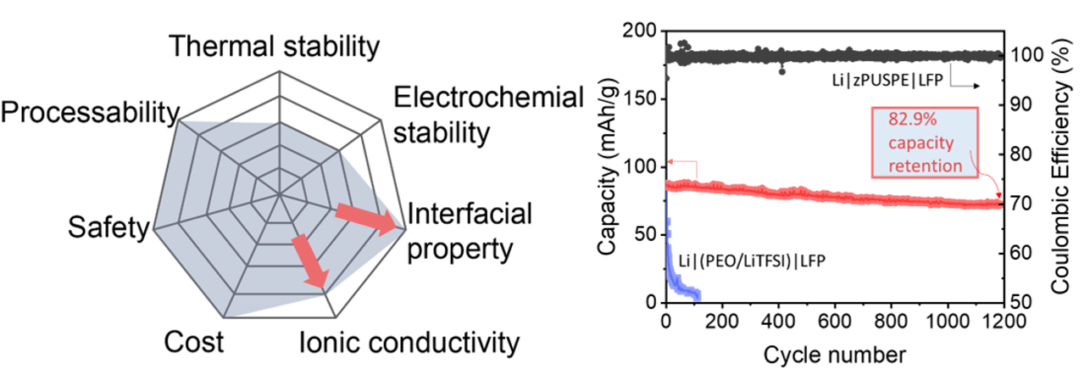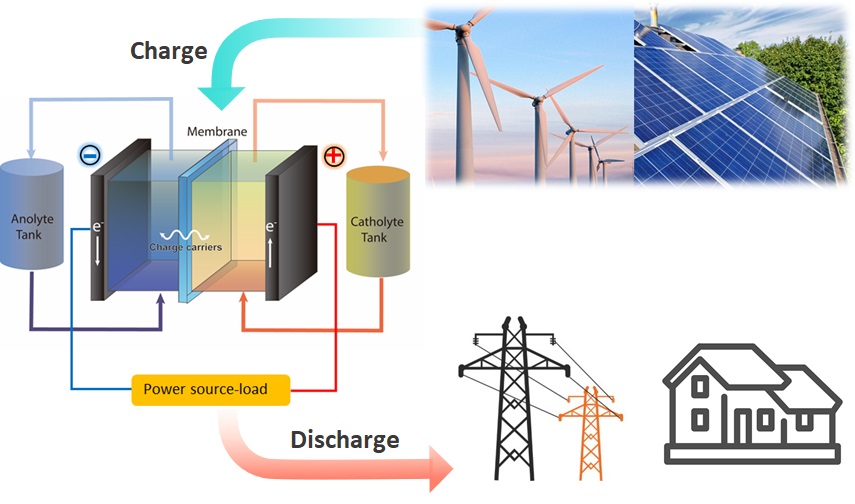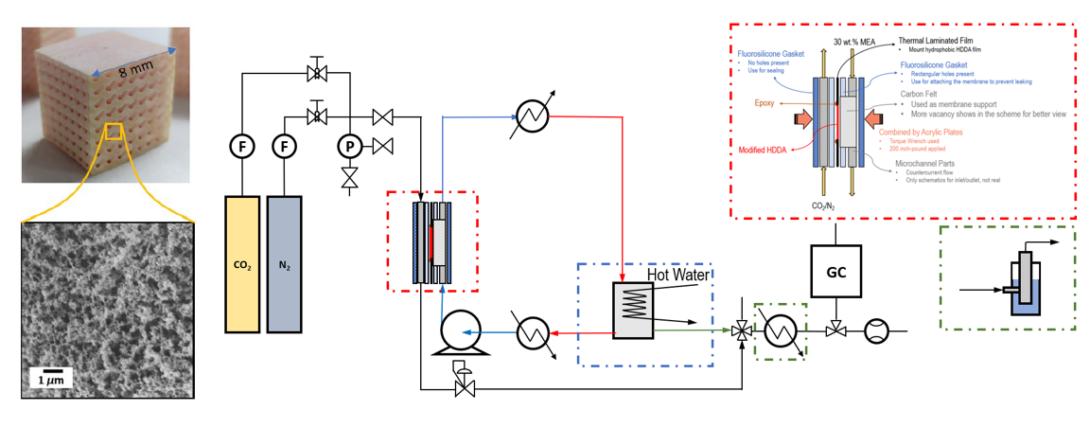Introduction
The following projects demonstrate the use of nanostructured membrane materials in developing a vibrant research program in membrane science and technology:
Zwitterionic Polymer Electrolyte for All-Solid-State Lithium Batteries

Lithium-ion batteries (LIBs) have been widely used in portable electronic devices, electric vehicles, and scale energy storage. Unfortunately, conventional organic liquid LIB poses a considerable challenge of safety concern. Meanwhile, current all-solid-state batteries cannot balance stability, surface property, and ionic conductivity. Here we are developing an all in one zwitterionic solid polymer electrolyte (zPUSPE) for high-performance lithium ion battery. The zPUSPE has balanced conductivity, stability, and surface property, which give zPUSPE high potential to serve as next generation SPE to be used in a variety of energy storage applications.
High-Efficiency Biomimetic Electrochemical Ion Pumping for Rapid and Selective Lithium Extraction

Compared to current solvent-based extraction technologies, electrochemical lithium ion pumping (ELIP) can offer environment–friendly, low energy consumption and high efficiency lithium ion recovery from a variety of sources including industrial wastewaters. Experimental synthesis and characterization of new electrode materials guided by computational modeling can facilitate the design of novel, stable, high lithium ion capturing capacity of the electrode materials. We employs a suite of characterization tools to quantitatively correlate their geometric/electronic structures with their electrochemical performance, and thus we will validate our theoretical predictions. AI-based optimal design of 3D electrodes can increase surface area of active materials by two orders of magnitude and 3D printing of hierarchical 3D electrode structure can offer a new way of manufacturing. This is collaborative work with Prof. Kyoo-Chul Kenneth Park at Northwestern University.
High-performance Ion Exchange Membranes for Redox Flow Battery Application

Enhancing ion conductivity and ion selectivity simultaneously while maintaining electrochemical and dimensional stabilities of ion-conducting membrane has been recognized as one of the most challenging issues for a membrane-based electrochemical energy storage and conversion process. For better realization of redox flow batteries (RFBs) for an industrial scale, it is also crucial to establish fundamental understanding of electrolyte chemistry as it is a critical prerequisite for delivering high energy density. In this work, our team tackles these two components in RFB by addressing the relationships among nanostructure of membrane, ion transport mechanism, electrolytes chemistry, solvent interactions, and electrochemical performance at the molecular level. Using a combination of modular material synthesis, nanoscale-to-bulk property characterization, and theory-guided interpretation, our work aims to bridge the scientific gaps that can overcome major bottlenecks of next-generation RFB systems.
Highly Ion Selective Membranes for Giant Osmotic Power Harvesting

Recent studies of the high energy-conversion efficiency of the nanofluidic platform have revealed the enormous potential for efficient exploitation of electrokinetic phenomena in nanoporous membranes for clean-energy harvesting from salinity gradients. Nanofluidic reverse electrodialysis (NF-RED) consisting of vertically aligned boron-nitride-nanopore (VA-BNNP) membranes is presented in our work, which can efficiently harness osmotic power. The transference number in the VA-BNNP is almost constant over the entire salt concentration range, which is different from other nanopore systems. Moreover, the BN deposition on the nanopore channels can significantly enhance the diffusio-osmosis velocity by two orders of magnitude at a high salinity gradient, resulting in a huge increase in power density. This is collaborative work with Prof. Jerry Shan at Rutgers University.
CO2 Absorption Membranes

CO2 absorption is a key to alleviating the environmental consequences of fossil fuel combustion, which is a major source of global CO2 emission. Membrane contactors have showcased several competitive advantages in CO2 absorption over conventional gas−liquid contactors, including a large mass-transfer area and a safe operation owing to the membranes that physically separate the gas and liquid phases. In this work, a novel 3D printed HDDA membrane based on gyroid architectures demonstrates several magnitudes larger membrane surface area in unit volume than the conventional membrane system, enabling ultrafast gas-liquid mass transfer hence CO2 adsorption. This is collaborative work with Prof. Juergen Biener and Jianchao Ye at LLNL.
Portable Plasma Separation Device for Point-of-care Diagnosis

Separation of large volume of plasma from blood is often required as the initial step in many clinical tests. We are developing a portable membrane-based plasma separator for onsite clinical diagnosis. The separator benefits from zwitterionic polymer surface coating that brings an ultralow fouling surface to the membrane. With its large plasma yield and good bio-marker recovery, the developed plasma separator is an excellent replacement of traditional plasma preparation protocols for point-of-care clinical tests.
High-efficiency Biomimetic 3D Zwitterionic Hemodialysis Membrane

On an annual basis, more than one million patients receive dialysis services all around the world. Current hemodialysis devices that sustain the lives of patients with kidney failure operate intermittently and are stationary, which limits the freedom of movement of patients. Here we are developing a high-filtration-efficiency and biofouling resistant 3D gyroid zwitterionic membrane that enable implantable or wearable artificial kidney.
Funding

Funding is received from the companies listed above.